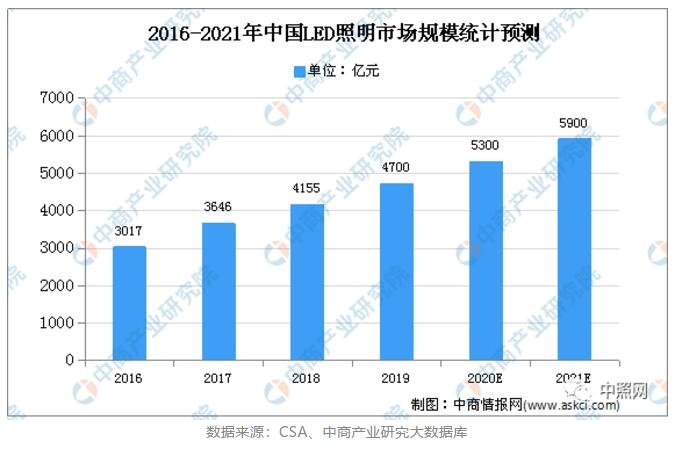As more and more areas step into the process of China’s urbanization development, the development of the industry, and the evolution of people’s needs, urban lighting gradually complete the upgrade from functional lighting to artistic landscape lighting to better serve urban residents and business activities.
Data show that the size of China’s LED lighting market output value grew from 259.6 billion yuan in 2015 to 415.5 billion yuan in 2018, with an average annual compound growth rate of 16.97%, a growth rate higher than the global average. It is expected that by 2021, the output value of China’s LED lighting market is expected to reach RMB 590 billion, and is still expected to be able to maintain a compound annual growth rate of more than 12% from 2019-2021.
Urban lighting industry development dilemma
1. Intensified competition in the industry
With the continuous promotion of smart cities, as well as the upgrading of cultural tourism night tour economy, the penetration of different industries will gradually deepen, and lighting engineering enterprises will also face competition from enterprises in other industries such as smart cities and cultural tourism in related businesses.
At the same time, with the continuous development of mobile, Internet of things, big data and cloud computing and other technologies, holding big data and huge traffic resources of Internet companies, in recent years also frequently seek to urban lighting industry cross-border development. With the continued development of the urban lighting industry, a number of lighting engineering enterprises have landed in the multi-level capital market, after opening the capital market financing channels, and gradually developed into the head of the lighting engineering field, the above-mentioned enterprises through the power of capital to receive more large-scale projects, making the industry more competitive.
2, the lack of high-end technology and management personnel to limit the development of the industry
City lighting industry due to the many areas involved, the process of training talent compared to other industries to be more lengthy. At present, there are more people working in the industry, but there is still a lack of high-end technical personnel. On the one hand, the planning and design of the link need to be combined with the geographical environment, cultural differences, so in the process of design solutions on the ground, the need for a large number of professional and technical personnel can deepen the design. On the other hand, most of the enterprises in the industry have backward management methods and lack modern management consciousness, and many of them do not have long-term development goals and are easily driven by short-term interests. The lack of technical and management professionals in the industry and the rapid development of the industry does not match the status quo, making it difficult for domestic enterprises to make long-term breakthroughs in technology development, management, and other aspects.
Urban lighting industry development prospects
1, social development and policy to promote the favorable factors
In recent years, the country has developed the “13th Five-Year” urban green lighting planning outline, “13th Five-Year” national strategic emerging industries development plan, “13th Five-Year” energy saving and emission reduction Comprehensive Work Program”, “Thirteen Five” period of cultural industry development plan”, “Thirteen Five” energy saving and environmental protection industry development plan” and other policy documents to clearly encourage and support the development of urban lighting industry. In order to implement the national development strategy, provinces and cities have strengthened the urban lighting management and financial support. 2020 May 22, “2020 State Council Work Report” proposed to focus on supporting the “two new a heavy” (new infrastructure construction, new urbanization construction, transportation, water conservancy, and other major projects) construction. This has brought about the policy guidance represented by “new infrastructure”. The introduction of various national policies has provided good policy guidance and support for the industry, which has played a positive role in promoting the stable, healthy, and orderly development of the industry.
2、Favorable factors of urbanization development and upgrading
In China’s urbanization cycle, China’s urbanization rate has reached 60.60% in 2019, but compared with the world’s developed countries, China’s current urbanization rate is still at a low level, is expected to be the next ten years of China’s urban market scale of steady growth, which will become the market basis for the sustainable development of the urban lighting industry.
3, spiritual pursuit and quality improvement of favorable factors
People’s pursuit of the city and the building night scene is no longer just ornamental but also hope that the cultural and artistic level of the urban landscape to bring spiritual enjoyment. Lighting and culture, technology, and other elements combined to create interactive lighting devices, lighting music miniatures, large-scale live interpretation of the light show, to create innovative, connotative urban lighting space that can meet the growing spiritual pursuit of people so that people in the night scene to experience the full range of urban space light environment.
4, smart city development of favorable factors
In recent years, with the development of the Internet of things, big data, mobile communication technology, the development of smart cities in breadth and depth are constantly breaking through. The smart lighting system can not only improve the level of control of urban lighting, energy-saving, and consumption reduction goals but also can integrate video monitoring, environmental monitoring, disaster warning, and many other functions, to provide technical support for the city’s information and intelligence management. On the basis of the overall lighting IOT of the city, richer sensing facilities, energy-saving lighting, video monitoring, help alarm, public broadcasting, electronic screen information release, wireless WIFI, environmental monitoring, intelligent charging pile, and other objects are incorporated into the sensing network to provide more basic data support for the smart city and expand more wisdom services.

